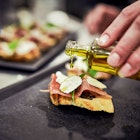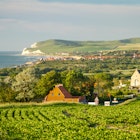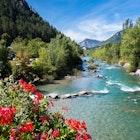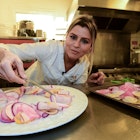Lonely Planet has produced this article for Vaucluse Tourism in Provence. All editorial views are those of Lonely Planet alone and reflect our policy of editorial independence and impartiality.
Provence has long been associated with the finer things in life, and justifiably so. Not only is the region a feast for the eyes, but it is also a feast for the tastebuds. There are, however, three products from the terroir (land) – wine, truffles and olive oil – that are essential to the fine art of living á la Provençale.
The long and wine-ding road
Provence’s red wines and especially those of the Gigondas vineyards, some 15km east of Orange, have gained cult status among wine aficionados worldwide. This bijou Appellation d’Origine Contrôlée (AOC; trademark body) produces reds known for their robust, full-bodied character, which is due to the combination of an exceptionally dry, chilly mistral wind and an equally exceptional, hot, ripening sun. The tiny slow-paced medieval village of Gigondas is well worth a gander in its own right. Perched on a hilltop, it features a ruined castle and a campanile, both affording superb vistas over the vineyards that ribbon the hillsides around the village.
Another prestigious vintage is red Châteauneuf-du-Pape (AOC), which covers just 32 sq km between Avignon and Orange. This earthy, well-structured wine has a high alcohol level (between 12.5% and 15%) and is a traditional accompaniment to game and sauced meats.
If you want to learn more about Châteauneuf-du-Pape (and other appellations from the Rhône Valley) wines, an essential port of call is the Musée du Vin (www.brotte.com), which has an exhibition about the area’s soils, ceépages (grape varieties) and winemaking techniques and also provides a prime wine-tasting opportunity.
You can also contact the Ecole de Dégustation (www.oenologie-mouriesse.com) – this school runs wine-tasting courses and workshops (two hours, in English) led by oenologists. The local tourist office has a list of wine shops and estates in the area you can visit to taste and buy – some require advanced reservation and have English tours.
Other charming wines to taste in situ include Côtes du Ventoux and Côtes du Luberon. Both labels are known predominantly for their light and fruity reds. Make sure you stop at Maison de la Truffe et du Vin (www.vin-truffe-luberon.com) housed in a former hospice in the village of Ménerbes, which represents about 60 domaines (estates). And yes, it also offers wine-tasting sessions.
Image courtesy of Vaucluse Tourism in Provence.
Black diamonds in the rough
Provence’s most precious ingredient is a fungus. But what a fungus! It looks far from appetising but it’s not called ‘the black diamond’ for nothing – one kilogram of top-quality black truffle may cost up to Euro1500 on the wholesale market.
The black truffles that are found in the Vaucluse region, which make up 80% of truffle production in France, are renowned for their unique fragrance. The black truffle (Tuber melanosporum) takes root underground, usually in close proximity to the roots of oak trees. They are snouted out by specially trained dogs in the Vaucluse, especially around Carpentras, Vaison-la-Romaine and Richerenches, in the winter months. Black truffles are highly sought after by local chefs who rave about their culinary and sensory properties and use them in many recipes to add taste and aroma.
For visitors there are great opportunities to discover the mysterious, fascinating world of black truffles. A number of chambres d’hôtes (B&Bs) organise truffle hunts with trufficulteurs (truffle growers) as well as visits to the truffle markets at Richerenches, Vaison-la-Romaine or Valréas, from mid-November to mid-March. They also arrange cooking classes and cook special truffle meals in season. The Maison de la Truffe et du Vin (www.vin-truffe-luberon.com) in Ménerbes has dedicated truffle-tasting workshops during which you can discover the taste of fresh truffles.
Vive le olive oil!
While people assume olive oil is solely a product of Italy or Spain, it also goes hand-in-hand with Provence. Originally planted by the Romans, the vast olive groves that dot the Provençale landscapes contribute to making France one of the world’s largest olive-oil producers.
Provençale olive oil can be bought direct at the moulin (mill), at specialist shops or at markets in the region. Depending on the terroir (soil) and the variety of olive, oil can have a varying degree of sweetness or acidity. Like wines, most Provence olive oils have an AOC stamp, which certifies their origin and quality. In the Vaucluse, the area around Apt and Carpentras is particularly renowned for their high-quality olive oils.
A number of working olive farms and mills conduct tours, often with tastings. In the town of Nyons (close to northern Vaucluse), the Institut du Monde de l’Olivier (www.afidol.org) runs olive workshops with tastings from July to September.
Some oléiculteurs (olive growers) also run B&Bs and are happy to show their estates to their guests and answer questions about olive-oil production. Near Carpentras, Le Moulin de Quenin (www.laquenin.fr) has attractive rooms in a 17th-century house amid a seven-acre olive grove. It produces a stunning AOC organic olive oil.
Experience the authentic produce, cuisine and ‘art de vivre’ of the Vaucluse region of Provence. Start exploring at www.provenceguide.co.uk
















